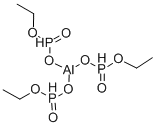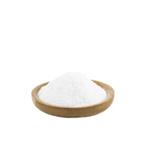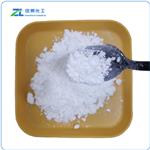Chemical Properties
White, crystalline solid or powder. Odorless.
Uses
Agricultural fungicide.
Uses
Fosetyl-aluminium (fosetyl-Al) is a systemic fungicide effective in
controlling various Phycomycete diseases, in particular the downy mildews,
Phyfophfhora and Pythium spp. It has also shown useful activity
against several bacterial plant pathogens (e.g. Erwinia amylovara). It is
widely used on a variety of crops including vines, fruit (bananas, citrus,
pineapples, avocados, stone fruit and pome fruit), berries, vegetables,
hops, ornamentals and turf.
Uses
Fosetyl Aluminum is a fungicide. It is highly inhibitory in vitro against several species of Phytophthora.
Agricultural Uses
Fosetyl aluminum can be used as Fungicide: used on fruits, vegetables and nut crops; also on ornamentals and greenhouse products.
Trade name
32545 R®; ALIETTE®; ALIETTE® 80 WG;
CHIPCO® ALIETTE WDG; EFOSITE-AL®; EFOSITE
ALUMINUM®; EPAL®; LS-74783®; MIKAL®
Potential Exposure
Organophosphate fungicide used on
fruits, vegetables and nut crops; also on ornamentals and
greenhouse products.
Environmental Fate
Plant. Felsot and Pedersen (1991) reported that fosetyl-aluminum degrades in plants forming phosphonic acid which ionizes to the dianion phosphonate, HPO3–2.
Metabolic pathway
Fosetyl-Al undergoes rapid and extensive degradation and metabolism
in soil, plants and animals. Cleavage of the P-O-ethyl linkage yielded
phosphorous acid, ethanol and naturally incorporated components as the
terminal products (Scheme 1).
Shipping
UN2783 Organophosphorus pesticides, solid,
toxic, Hazard Class: 6.1; Labels: 6.1-Poisonous materials.
UN3018 Organophosphorus pesticides, liquid, toxic,
Hazard Class: 6.1; Labels: 6.1-Poisonous materials.
Degradation
Aqueous solutions of fosetyl-Al undergo rapid degradation in strong
acidic and alkaline conditions (1) with observed DT
50 values of 5 days
(pH 3) to 13 days (pH 13) but exhibit higher stability at pH values
closer to neutrality (Bertrand et al., 1981). However, the results of biodegradability
studies suggest that fosetyl-Al is readily biodegradable in
environmental water (Mead, 1996).
Incompatibilities
In the presence of strong reducing agents
such as hydrides, organophosphates form highly toxic and
flammable phosphine gas. Contact with oxidizers can cause
the release of toxic oxides of phosphorus. Decomposes in
temperatures above 260℃.
Waste Disposal
Destruction by alkali hydroly sis or incineration. Containers must be disposed of properly
by following package label directions or by contacting your
local or federal environmental control agency, or by con tacting your regional EPA office.




